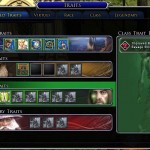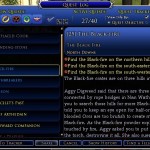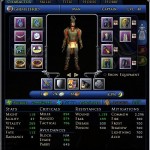This is the second part of what started out as a small review of Lord of the Rings Online and has turned into an epic monster. You can check out the first part back here, and parts three and four are coming up after this one. This bit (part 2) deals with the system aspects of the game, i.e. how things work.
2. System
It doesn’t really matter how much awesome content there is in a game, if the system behind it sucks like an open chest wound. People will only put up with so much pain to get to the content they enjoy. Systems have come a long way since the early online roleplaying games which extolled the virtues of lots of hard work for small increments in power. These days developers realise the casual gamer market is just as key to the success of a game, and people with families can’t commit to six straight hours in front of a keyboard every night. Systems have developed that allow casual gamers to get the most from games but still offer opportunity for complex character development and fine tuning.
2.1 Combat
Despite being a roleplaying game we all know that the core activity at the centre of LoTRO is engaging in combat. The enemy is moving, Sauron grows restless and there are goblins, orcs and evil things aplenty to be killed. It’s critical therefore that the combat system is both easy to use up front, and interesting to use after a thousand times. All combat actions in LoTRO are based on skills. The system is very similar to World of Warcraft (WoW), with each skill having a graphical icon representing it, being placed into a quick slot and clicked or a matching hot key pressed to activate it. Each character does a base amount of melee damage if in close combat (or basic ranged damage if they have a ranged weapon) to their current target without any key presses (auto attack). The additional skills provide more damage or different effects. New skills are gained as you increase in levels after being purchased for coin from a class trainer. As well as active skills (that you must click), classes get passive skills which determine their ability to dodge, block, use armour, shields, and wield different weapons.
At early levels characters tend to get one additional skill attack that does slightly more damage. Skills use power for everyone (the blue bar in some of my screen shots) and sometimes a class specific thing (only word I could think of) such as fervour (Champions). The number of skills is huge, even for a single class the range of skills they get is very broad. Skills tend to scale and continue to be used as you level, rather than being upgraded, this can lead to a lot of quick slot buttons being required. Skills have a cooldown period before they can be used again ranging from seconds to hours, and some skills have an induction period which is how long the skill takes to use and can be interrupted which ranges from instantaneous to a few seconds. Skills often have triggers which can be other skills or things such as mob death. These triggers can be complex, for example, Guardians can trigger a shield bash, which leads to an area-of-effect taunt if it lands, which leads to a further more damaging shield bash if that is used. Here’s a few random sample skills,
- Guardians get an attack which does minor damage but also provides a self buff which increases their defensive skills.
- Champions get a fast-attack skill which builds a small amount of fervour, when they have enough fervour they enable another skill which hits up to 5 enemies nearby.
- Minstrels get a skill which increases the melee DPS of everyone in the group for 10 seconds.
- Loremasters get a skill that slows their target’s attacks for a short duration.
That’s a tiny example of the skills available, they range from damage, debuffs, buffs, stuns, fears through to ‘heals’, feigning death, returning people to combat after they ‘die’, and a whole range more.
Actual combat is fast and furious. There are no hitpoints in LoTRO and no death. Each character has an amount of morale which when depleted forces them to withdraw from combat. Healers actually restore morale through song or other methods, rather than healing wounds. Once defeated (out of morale) you can be recovered by a nearby ally with the relevant skill (minstrel for example) if they manage to rouse your morale and encourage you back into the fight.
Fights against appropriate level creatures for DPS classes can be over in a few seconds, for tanking classes it make take 3 or 4 times as long. In a full fellowship regular creatures are killed so quickly it can be hard to keep up. However, creatures come in varying levels of toughness, fro
m regular to Signature, Elite, Master, Elite Master and more. Signature creatures are a good challenge solo and easy for groups. Elite mobs are pretty hard to kill solo and a good challenge for a full group. Masters and beyond are tough no matter who you are with.
Enemies use a full range of tactics against you from ranged attacks to stuns and knockdowns.
Your own fellowship can bring crowd control (fear, stun, sleep) tools to bear on multiple targets or you may adopt a full dps approach if you have a few champions or hunters nearby.
The range of skills within a class and across all the classes, the different types of enemy and the different choices for dealing with encounters made of many enemies make for quite a complex combat system which is still easy to engage with. If you pick quests a couple of levels below your level then combat will be pretty easy and a simple dps-fest, however if you pick more challenging quests then you’ll need to use all of your character’s and fellowship’s skills to defeat the enemy and succeed in your task. This provides an excellent method for catering to both casual and non-casual gamers which is often self selecting.
2.2 Stats
Characters in LoTRO have a few different sets of statics. The core list is Might, Agility, Vitality, Will, Fate and Radiance. Most roleplayers could take a guess at what the first four affect but Fate and Radiance might be new. In fact, the core statistics have a broad range of effects, for example Might not only affects how much damage you can do but also how well you block incoming attacks. Agility does affect how well you evade attacks but also how accurate you are with a bow. So it’s definately worth checking out the effect of these statistics, and the very best thing about Lord of the Rings Online is that it tells you. If you hover over a statistic on the character inventory screen it describes the impact it has (Fate improves your morale and power regeneration and Radiance increases your hope which helps during encounters with tough enemies).
Those statistics work together, along with armour values, to generate the second set of characteristics. Combat criticals (melee, ranged and tactical), combat defenses (block, evade, parry) and mitigation against common damage (i.e. stuff that hits you). Again, hovering the cursor over one of those values actually tells you how effect it is (1412 block might give you a 12% chance to fully block an attack or 24% chance to partially block an attack, for example and you will see those numbers in-game). Armour also contributes towards other mitigations such as acid and frost which reduce damage from those sources.
All of the above add up to give you a value for Morale and Power which you use to survive combat and power your skills. Lastly you have a set of values which describe your resistances to various effects such as wounding, fear, disease and poison.
As I said above, the very best thing about these statistics in LoTRO is that they’re clearly explained. You may not know if you need more Might than Agility but you will know the numerical impact of picking one over the other which is very nice.
2.3 Traits
 Gear choices lead to increases in the basic statistics for your character (armour value, morale, power, might, etc., etc.) However, there is a more indepth method for customising your character and that is based on traits. This is actually a pretty big area of the game and it would take an entire second review to discuss it, so I’ll provide the basics only here.
Gear choices lead to increases in the basic statistics for your character (armour value, morale, power, might, etc., etc.) However, there is a more indepth method for customising your character and that is based on traits. This is actually a pretty big area of the game and it would take an entire second review to discuss it, so I’ll provide the basics only here.
There are four types of trait, class specific, race specific, generic (called virtues) and legendary (earned through long quests or tasks at higher levels). Traits can provide new skills, improvements to old skills, increases in the basic statistics for your character or direct increases to calculated values suck as block or evade.
Traits are earned in different ways as well. Race specific traits are usually earned through killing many creatures that your race has a particular emnity for. Hobbits for example dislike wolves a great deal, while Elves really don’t get on with drakes. Class traits are usually earned by using certain skills many times, for example after using his self buff skill attack 300 times, a Guardian might receive a class trait which improves the buff received.
Virtues which are the most general and numerous traits are earned through quests and deeds, and legendary traits which are the most powerful and least numerous are earned through long quests collecting pages of missing tomes.
Although you can earn many traits, you can only have a limited number in play at any time, and changing them requires a visit to a bard and the handing over of hard earned cash. The more powerful the trait the more expensive to change it. As you gain levels the number of traits you can have slotted increases.
As you can see from that overview, it’s a potentially complex and rich method for customising your character, but you can invest as much time in it as you wish. Working hard to complete every quest, deed and task gives you more flexibility, and regular visits to the bard allow you to customise your character differently depending on your next mission. Or you can pick some good, generic traits and then forget about them for the most part.
The trait system is in-character, interesting and offers different levels of complexity based on your desired involvement, I like it. Additionally since none of it is set in stone, it’s more inviting to play with and less threatening to get wrong.
2.4 Fellowships
Fellowships are the grouping mechanic in LoTRO and can be six members in size. The tools for managing fellowships are quite rich, with several loot modes (including automatic rolling on items of certain quality), all members showing up on the maps and built in voice chat. There’s not much else to say other than this side of things works well. The best feature of fellowships is actually a cross-over feature with the quest log, so I’ll leave that for the next section.
2.5 Quest Log
 If quests are the meat of online roleplaying games, the quest log is the sauce and side dishes all rolled into one. If this tool gets in the way or doesn’t provide any benefit then it’s a wasted opportunity. The log in LoTRO has gone through several changes since I first started playing and the current incarnation is superb. Firstly the log does its main job which is provide you with a list of the tasks you have outstanding, the suggested level and your progress. However as soon as you join a fellowship, it also shows you the progress of your fellowship members on all the quests you have in your log. You can see if they have the quest, have completed it, if they aren’t elligable for it or if they don’t yet have it. You can use the log to share quests with people who are elligable as well. The ability to see where your fellowship members are on a quest is superb, although it is a little buggy and can sometimes take a while to populate correctly when new people join.
If quests are the meat of online roleplaying games, the quest log is the sauce and side dishes all rolled into one. If this tool gets in the way or doesn’t provide any benefit then it’s a wasted opportunity. The log in LoTRO has gone through several changes since I first started playing and the current incarnation is superb. Firstly the log does its main job which is provide you with a list of the tasks you have outstanding, the suggested level and your progress. However as soon as you join a fellowship, it also shows you the progress of your fellowship members on all the quests you have in your log. You can see if they have the quest, have completed it, if they aren’t elligable for it or if they don’t yet have it. You can use the log to share quests with people who are elligable as well. The ability to see where your fellowship members are on a quest is superb, although it is a little buggy and can sometimes take a while to populate correctly when new people join.
The latest new function handled by the quest log is actually holding onto quest items. Previously items required for various stages would sit in your inventory (and you couldn’t put them in the bank) taking up precious space. Now they go into the quest log entry itself, freeing up significant inventory space if you’re a bit of a quest hound working on lots of things at once.
Your active quests can be displayed on the screen (up to 5 at a time) with the various stages you’re at for each of them. Each time you complete a quest task the on-screen list updates to show that one and drop the one you updated last. You can also choose to pin quests to the screen so they don’t get dropped if you need a reminder of what to do.
You can if you want look at every quest you ever completed, although it can take up to 3 minutes for my computer to switch to this quest log mode so it’s not advisable to try it all the time.
2.6 Item Wear
I’m not usually a huge fan of item wear in games and while this feature is in LoTRO, I manage to tolerate it. During normal play item wear builds up slowly and you must visit any vendor and pay for repairs. In the early part of the game this probably uses most of your cash. Combat is the biggest cause of wear, and long periods of fighting and being hit can get expensive, especially for the tanking classes. Defeat in combat also causes a significant amount of wear on your items and is the prime reason for hoping an ally can restore your morale with a song or smoke of the pipe (no jest). This usually annoying feature is only a muted twinge in LoTRO and while I could do without it, it doesn’t ruin my play and does at least provide some incentive for not being defeated in every single fight.
2.7 Summary
Thankfully I kept this section shorter than part one. In summary, once again I’m impressed with the system behind Lord of the Rings Online. It is involving and has multiple layers of complexity, but you can use it at the level which you feel most comfortable with. If you want to complete quests a level or two below your current character level you can get away with pretty simple combat tactics, not worry about your traits and not really care how good your gear is. If you want to push hard and beat quests 3 or 4 levels beyond you then you’re going to need to check your traits more often, make sure you’ve got gear at the right level and learn what statistics suit your skills the best.

